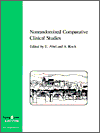
|
| Nonrandomized Comparative Clinical Studies - Proceedings of the International Conference on Nonrandomized Comparative Clinical Studies in Heidelberg, April 10 -11,1997 |
 |
"Regardless of how wonderful randomized trials are –
and I will yield to no one in acknowledging them as the gold-standard when they can be done – they have some major problems and difficulties. ...
... One of them is "unstable" therapy, where potent new agents appear while the trial is in progress. For example, suppose we do a trial to test either surgery or a medical therapy versus the balloon angioplasty for coronary disease. While the trial is in progress people may develop stents or other new ways of reaming out the coronary artery that may be better than balloons.
By the time the trial is done, whatever we found may be obsolete because the stent may
have replaced the balloon. A second problem is to compare a new agent versus multiple
active treatments. For example, suppose I have produced a new treatment for hypertension:
Alvanol, my drug – it is wonderful! It lowers blood pressure gently, but firmly. It
does not affect any metabolism. And whatever needs to be done to the libido it does. If
the libido needs to be raised, it raises it. If it needs to be lowered, it lowers it. It
is an absolutely wonderful drug for the treatment of hypertension. What do I compare it
against? There are 85 different new drugs out there for hypertension. And by the time you
finish reading, there may be 86. How do I choose which one? And if I compare it against
placebo you may say I am unethical."
(A.R. Feinstein, Yale University School of Medicine, see: Problems
of randomized trials)
Epistemological aspects and general considerations
Problems of randomized trials
A. R. Feinstein
Yale University School of Medicine, Clinical Epidemiology Unit, 333 Cedar Street, New
Haven, CT 06520-8025, USA
The mythology of randomization
U. Abel, A. Koch
Abteilung Medizinische Biometrie, Universität Heidelberg, Im Neuenheimer Feld 305, 69120
Heidelberg, Germany
Experimental study versus non-experimental study:
the non-experimental (non-randomized) study as a methodological compromise
K. Dannehl
Diabetes-Forschungsinstitut an der Heinrich-Heine-Universität Düsseldorf, Abteilung
Biometrie und Epidemiologie, Auf’m Hennekamp 65, D-40225 Düsseldorf
Evidence based conclusions on the efficacy of
a treatment - What can be learned from risk assessment ?
L. Edler
Biostatistics Unit - 2070, German Cancer Research Center, Im Neuenheimer Feld 280, D-69120
Heidelberg